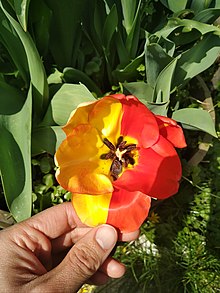
Mosaicism or genetic mosaicism is a condition in which a multicellular organism possesses more than one genetic line as the result of genetic mutation.[1][2] This means that various genetic lines resulted from a single fertilized egg. Mosaicism is one of several possible causes of chimerism, wherein a single organism is composed of cells with more than one distinct genotype.
Genetic mosaicism can result from many different mechanisms including chromosome nondisjunction, anaphase lag, and endoreplication.[3] Anaphase lagging is the most common way by which mosaicism arises in the preimplantation embryo.[3] Mosaicism can also result from a mutation in one cell during development, in which case the mutation will be passed on only to its daughter cells (and will be present only in certain adult cells).[4] Somatic mosaicism is not generally inheritable as it does not generally affect germ cells.[2]
- ^ Campbell, Ian M.; Shaw, Chad A.; Stankiewicz, Pawel; Lupski, James R. (2015-07-01). "Somatic mosaicism: implications for disease and transmission genetics". Trends in Genetics. 31 (7): 382–392. doi:10.1016/j.tig.2015.03.013. ISSN 0168-9525. PMC 4490042. PMID 25910407.
- ^ a b Forsberg, Lars A.; Gisselsson, David; Dumanski, Jan P. (February 2017). "Mosaicism in health and disease — clones picking up speed". Nature Reviews Genetics. 18 (2): 128–142. doi:10.1038/nrg.2016.145. ISSN 1471-0064. PMID 27941868. S2CID 44092954.
- ^ a b Taylor, T. H.; Gitlin, S. A.; Patrick, J. L.; Crain, J. L.; Wilson, J. M.; Griffin, D. K. (2014). "The origin, mechanisms, incidence and clinical consequences of chromosomal mosaicism in humans". Human Reproduction Update. 20 (4): 571–581. doi:10.1093/humupd/dmu016. ISSN 1355-4786. PMID 24667481.
- ^ Strachan, Tom; Read, Andrew P. (1999). "Glossary". Human Molecular Genetics (2nd ed.). New York: Wiley–Liss. ISBN 978-1-85996-202-2. PMID 21089233.[page needed]